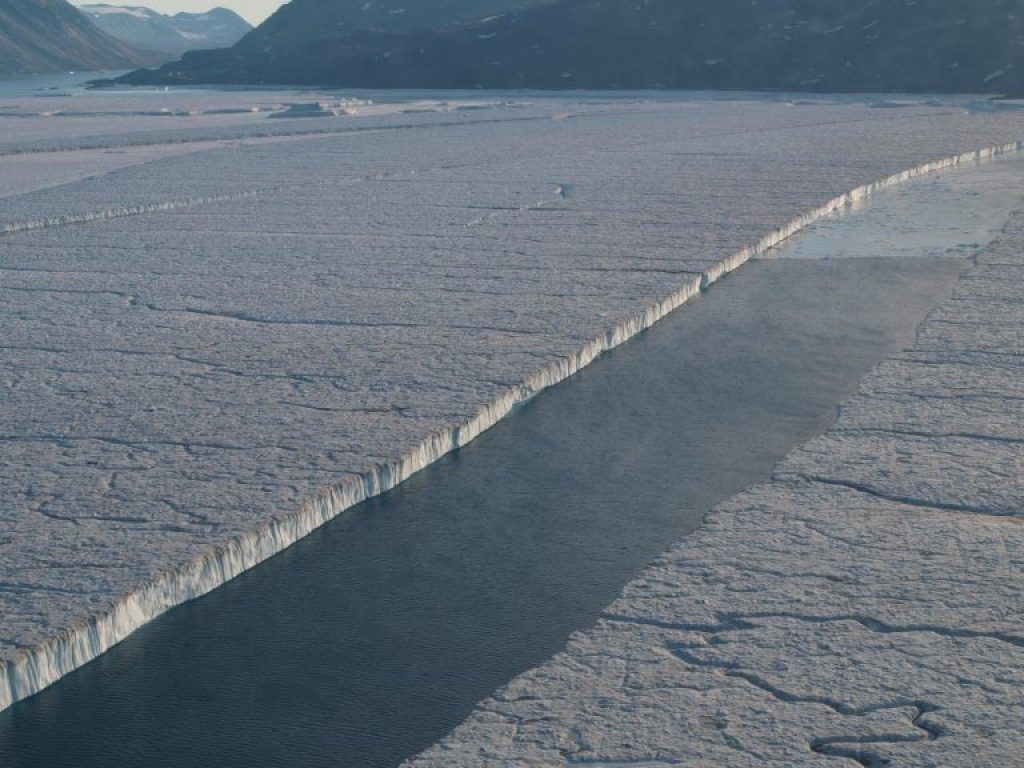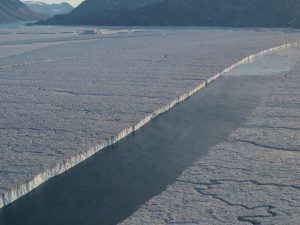Table of Contents
Master’s student Karina Hansen appeared at the door to my office at GEUS: “something looks strange” at Spalte Glacier connected to the 79 Glacier far northeastern Greenland.
In Danish, Spalte means “split” or “crevassed”.
The ~9 km wide Spalte Glacier is a tributary of the 79 Glacier which today has the Arctic’s largest ice shelf. The ice shelf forms the end of the North East Greenland Ice Stream, the only Greenland ice stream clearly reaching the highest elevations.


We observed that between 14 Aug., 2015 and 3 September 2016, a marine-terminating tributary of the 79 fjord glacier, the Spalte Glacier flowing into Dijmphna Sound has detached and area (more than 95 km2) roughly the area of Manhattan Is.
The detachment of the ice shelf fragment appears to be nearly 100% complete.
The floating ice shelf fragment appears to have split into more than one piece already. But the main fragment have not floated away yet. I expect that will happen this year or next.
The fracturing and detachment is partly due to glacier dynamics (flow, stress, strain, pre-existing fractures).
Whether the ice shelf detaching is the consequence of the record warm ‘summer’ (June through August) observed at the DMI Danmarkshavn meteorological station (332 km to the south) is an obvious question.
Using Danish Meteorological Institute air temperature data c/o John Cappelen, the absolute summer temperature at Danmarkshavn was +4.9 C, producing a +2.3 C anomaly from the 1981-2010 “normal” period having temperature +2.6 C.
At Station Nord (220 km to the north) July temperatures were +1.9 C above the 1981-2010 period. Absolute July temperature at Station Nord was +5.9 C, producing a +1.9 C anomaly from the 1981-2010 ‘normal’ period having temperature +4.0 C). The Station Nord summer average temperature was +3.1. Normal is +2.3. So the Station Nord summer temperature anomaly was +0.8 C.
With a few exceptions, marine terminating outlets of the Greenland ice sheet have been retreating in recent decades. Box and Hansen (2015) surveyed 45 of the widest Greenland glaciers, which between 1999 and 2015 collectively lost an area of 1799 square km.
A Clear Statistical Pattern
Summer air temperature records at all 11 Danish Meteorological Institute stations around Greenland are correlated with glacier front area change… in warm summers, more ice area is lost. At 4 of the 11 sites, the confidence in that correlation is above 95%. At 7 of the 11 sites, the confidence in that correlation is above 80% (Box and Hansen, 2015). The physical mechanisms at work are probably hydrofracture in which the weight of water, being more than ice, adds force that can disaggregate ice (e.g. Weertman, 1973; Van der Veen, 1998) and forced convection driving more heat exchange between the (overall warming) ocean and the ice underbelly.
USGS Landsat 8 image sequences below prepared by Karina Hansen and myself.

